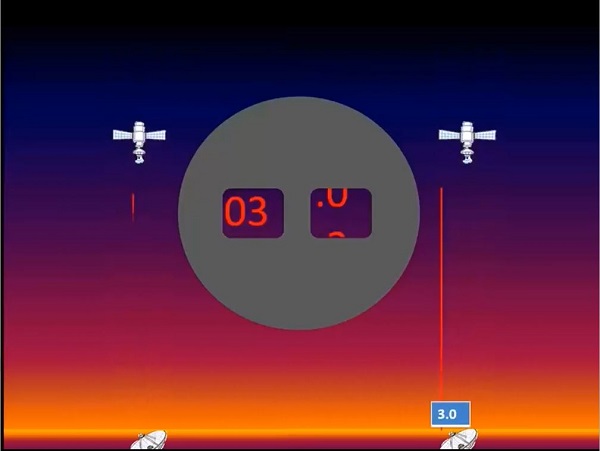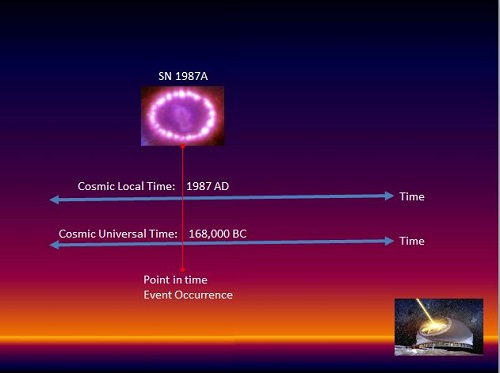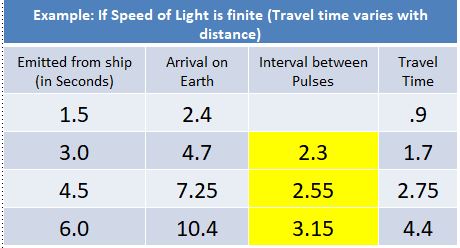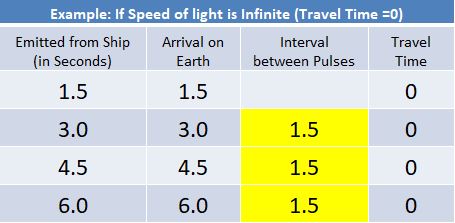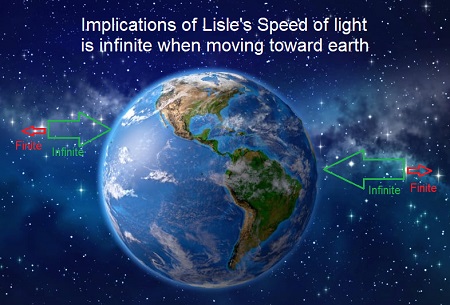|
|
At the conclusion of my first two-part series (part 1, part 2) on distant starlight, it seemed clear to me that I should revisit this topic specifically to address the issues with Lisle’s ASC theory. I want to address specifically the issues with Lisle’s ASC theory. I initially thought it provided the best solution to the distant starlight problem. But after much study on the matter i came to the matter I came to the conclusion that not only does Lisle’s theory fall to Occam’s razor, if a key required stipulation is not true concerning light, it doesn’t even qualify to explain a 6,000 year old creation. I was thus forced to conclude Danny Faulkner’s Dasha theory (essentially God did it somehow – we don’t know how) is the best answer. But I wanted to return to Lisle’s ASC and look more closely at what I consider the failings of the theory that I thought when I started the previous series would be the preferred solution to the distant starlight problem.
I've defined the distant starlight problem at least two times before (probably more): both in the original series where I look at both the problem and suggested solutions compatible with the Biblical account, (Distant Starlight – Under Occam’s Razor – Part 1: Contenders), and in part 1 of this current series (Distant Starlight Unlikely Solutions Part 1: Light In Transit). So instead of making this like a new Batman movie where the writers feel compelled to spend an inordinate amount of time on the now familiar Batman origin story, telling it yet again, I will assume a basic knowledge of the problem, and will allow only the following single sentence to suffice as a summary of the problem:
If the universe is only 6,000 years old, how can we see distant starlight from stars that are millions, or billions of light years away?
Dr Jason Lisle has put forth a solution which he calls the anisotropic synchrony convention, or ASC for short. His solution is made possible because:
1. We do not know for sure the one-way speed of light; all we can measure is the two-way speed of light.
2. According to Einstein, the frame of reference for measuring the speed of light doesn't matter, the only thing that matters is that you're consistent with what you use, and that the two-way speed of light (abbreviated as "c" - it's the "c" in Einstein's famous equation E=mc2) remains constant at it's measured value (in a vacuum) of 186,000 miles per second.
Given those constraints here is a broad outline of Lisle's ASC solution to the distant starlight problem:
1. With reference to time, there are two-ways to measure when events in space happen. Either by reference to when you see the event on earth - call it "cosmic local time" (CLT); or when the event actually happened, call that "cosmic universal time" (CUT)[1]. Both imply some amount of time between when an event happened, and when a distant observer sees the event. The only difference is the reference point from which the event is measured. Consider the diagram below. Super nova SN1987A is 168,000 light years from earth, and was first seen in 1987. Presumably that means the event happened 168,000 years ago, and the light from the explosion travelled through space 168,000 years to arrive at earth in 1987. But astronomers use CLT and name it SN1987; not CUT which would require a datum line. For illustration purposes - we'll use the BC/AD datum line, and then the name would be something like SN168,000BC. (In round numbers dropping the 2 millennia since 1 AD). The illustration below shows two different ways of referring to the same event, using different time conventions:
2. The distant starlight problem exists because scientists tend to use cosmic universal time, because it simplifies equations and is just easier to work with. (But not exclusively; astronomers use CLT to name astronomical events like supernovas as noted above.) But it could be, given descriptions in Genesis, that God is using CLT. Consider the description of the creation of the stars:
14 And God said, "Let there be lights in the expanse of the sky to separate the day from the night, and let them serve as signs to mark seasons and days and years,
15 and let them be lights in the expanse of the sky to give light on the earth." And it was so.
Gen 1.14-15
It appears that God speaks the event - let there be stars... to give light on the earth...and it was so. So it seems that as soon as God speaks it, what he spoke happens. Thus it appears that God is using CLT - cosmic local time to describe the event.3. Using CLT solves the problem of getting the light there by day four. But there's an implication that in order to do that, the light actually started travelling thousands (in the case of sn1987), or millions or billions of years ago depending on the star's distance. In this case it appears that using ASC merely masks the problem.
Lisle's solution is that in addition to CLT, a 6,000 year universe is made possible because using CLT, you can define the one-way speed of light to be infinite. Recall that we can't measure the one-way speed of light, and Einstein says we can define to be whatever we want as long as the two-way speed = c. Thus Lisle argues he can define the one-way speed of light to be infinite when headed toward the earth, which both solves the distant starlight problem, and is consistent with God appearing to use local time - CLT instead of universal time (CUT).
I have three problems with Lisle's solution:
1. Lisle assumes that the one-way speed of light is conveniently infinite in the direction toward earth, which neatly solves the distant starlight problem. But is it?
2. Lisle claims that you cannot measure the one-way speed of light, so you can't test his theory. But his theory can in fact be tested.
3. Is Lisle equivocating in his use of the term ASC?
Lisle makes it sound like he's just changing conventions, but in
actuality, an infinite one-way speed of light being true and physically
real is critical to his theory.
Without it, even using ASC you're back to billions of years - which he
has acknowledged more than once. (For example in
this video
[2])
Yet he seems content to just assume the one-way speed of light is
infinite because he defined it that way, without seeking any tests to prove it. A strange position for a
scientist. Further, the speed is not really based merely on direction. A
key part of that direction is whether that direction means the light is
moving towards the earth, or away from it.
Let's start at Objection 1
Is the speed of light really infinite in one direction?
Lisle seems to play both sides of the fence here. He states since we
don't know the one-way speed of light we can choose it to be anything we
want. Fair enough, according to the definition Einstein gave for
simultaneity. (below) But the
problem comes when he acts like the speed he chose is actually the speed
that light is traveling at in the stipulated direction. This is in
contrast to Einstein, whom Lisle quotes in his own slide saying that the
stipulation you make is not "a hypothesis about the physical nature of
light." [3]
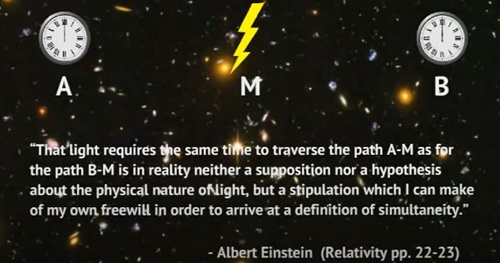
But Lisle is clearly using his hypothesis of an infinite one-way speed of light as a physical property of light. Otherwise you're back to using just ASC which means the light arrives in time on day 4, but it has been travelling millions of years to get there. Lisle admits this both in his video, and in his blog where commenter David MacMillan asks:
David MacMillan:
As far as I've been able to tell, the model of 4th-day creation using the anisotropic synchrony convention, if mathematically transformed back into a more traditional isotropic synchrony convention a la Einstein, implies the progressive creation of galaxies from the edge of the observable universe towards us over a period of many billions of years in the isotropic convention, such that all light reached Earth near-simultaneously on the 4th day. Is that an accurate understanding of the overall model you propose?Dr Lisle:
Yes(Emphasis mine)[4]
This indicates there is more than just the selection of a convention going on. If it's really just the selection of a convention - the actual, physical reality never changes. The only thing that changes is how you describe that physical reality. Let me give you an example from the world of aviation.
In order to fly, planes must have their center of gravity (CG) within
pre-defined bounds. Too far fore or aft and the plane becomes
increasingly unstable until - if moved far enough it becomes unflyable.
To make sure the CG is within prescribed limits, pilots do what is
called a weight and balance. They get the total weight of the plane - to
make sure it's not overweight, and they also make sure the weight is
distributed through the plane so that the CG stays within manufacturer-prescribed bounds. They do this by totaling up all the weights from a
given reference point called a datum line. Here is where
conventions come in. You can put the datum line anywhere you want. In
front of the plane, in the middle of the plane, behind the plane.
Literally anywhere, as the below pictures illustrate:
Cessna: Datum in front of the plane:
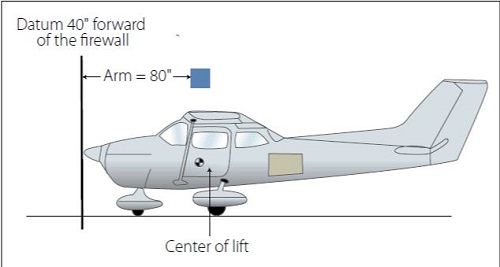
UltraCrusier: Datum at the leading edge of the wing:
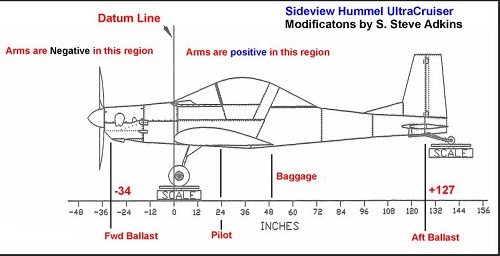
Bizjet: Datum through the nose in front of the cockpit:
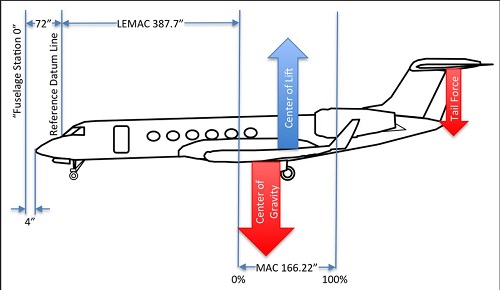
Here's what's true when it's merely a reference, a convention.
1. It's true you can chose whatever convention you want. (In this case
the placement of the datum line.) Above we see a datum line at three
different locations: In front of the craft, through the nose, and at the
leading edge of the wing. All are valid - because placement of a datum
line is in fact mere convention that can be stipulated and changed. This
is similar to how Lisle wants to change the timing convention.
2. Once the Datum lines are defined, all weights and moments (forces due
to the weights) must be defined with respect to the datum line. So with
the Cessna where the datum line is in front, it will have all moments as
positive numbers. When it's in the middle of the plane (as with the
UltraCruiser), you'll have both
positive and negative moments - representing weights on either side of
the datum line. The point being, you just have to be consistent. Which
is what Lisle points out using conventions, so that part is also true.
3. But notice the final item. In this aviation example, the CG (Center of Gravity) never changes. Regardless of how you describe it with reference to a datum line, the CG itself is ALWAYS at the same location.
This is NOT what's happening in Lisle's example. Lisle states that if
you change conventions, you wind up with billions of years for light
travel time. That should NOT happen in a 6,000 year old creation. You can listen to him state that yourself here:
(Listen for "shells" where each shell could be millions or billions of
years - which he leaves unstated.)
https://www.youtube.com/watch?v=GOXE_ILbGNU&t=1970s
He talks about the concentric "shells" of stars created would be "spread out." That "spreading out" would necessarily be done so over billions of years as he acknowledged to Dave McMillan above. Which means, this is more than just a change in convention, he's also relying on a change in the property of light as noted above. His theory REQUIRES the one-way speed of light to be infinite for his theory to keep the bounds of creation within a 6,000 year time frame, such that the distance of the "shells" is irrelevant.
Thus Lisle is indeed depending on not just a stipulation of a convention, but the actual physical property of the one-way speed of light being infinite. Otherwise his theory is a total failure as an explanation for distant starlight within the bounds of a 6,000 year old creation. I assume he wants it to remain a valid explanation, which means that his required stipulation must be true: The speed of light when moving toward earth must be infinite. But is it? Contrary to what Lisle seems to indicate, that hypothesis can be tested. That is the topic of objection 2.
Objection 2: Is it true that we cannot test if the one-way speed of light is infinite?
In his presentations, Dr Lisle claims his theory can't be tested because you can't measure the one-way speed of light. In fact in a video he says:
"And by the way don't come up to me and and say "I've thought of some way by which you can measure the one-way speed of light unless you've read 10 papers on the topic. Because physicists have been trying to figure this out for a hundred years and nobody has been able to do it." [5]
Jason Lisle
Okay, I won't tell him how to measure the one-way speed of light. But that doesn't mean we can't test his theory. We can test his theory by understanding the properties of light traveling at infinite speed. As Lisle himself points out, the travel time goes to zero - regardless of distance.
Since his hypothesis states the travel time of light will be zero, all we need to do to test his theory is send a probe (like Cassini) out into space and have it send back signals at a regular interval. In the illustration below it's 1.5 seconds. If the speed of light towards the earth is in fact infinite, you should note two things about the signal:
1. The interval between the signals will remain constant at 1.5 seconds regardless of distance.
2. The derived travel time will remain constant at zero, regardless of distance.
On the other hand if the speed of light is finite, you will observe:
1. The interval between signals will increase as distance increases.
2. The derived travel time will increase with distance.
Here is a graphic to illustrate that point:
Here is a reproduction of the charts at the end of the video:
What the video is trying to show are the two highlighted columns. If the speed of light toward earth is finite (table 1), then as the satellite moves further from earth, time between signals or "pings" will increase as will the total travel time of the light.
But if the speed of light toward earth is infinite (table 2), time between pings will remain constant regardless of distance, and the travel time will remain constant at zero, regardless of distance - confirming the property that the light is moving at infinite speed.
This experiment would either prove or disprove Lisle's theory that the speed light towards earth is infinite. The numbers used here, are of course only for illustration. What's important is the trend. When the speed of light is infinite, the interval between pulses will remain constant and the travel time will be zero.
On the other hand, if the speed of light is any finite number (like 186,000 miles a second) the interval will increase with distance, as will the travel time.
This is a simple experiment, if you can get access to a space faring probe, a laser emitter, and a very precise timer.
Objection 3: Is Lisle equivocating in his use of ASC when explaining his
theory?
Lisle defines the "anisotropic" in anisotropic synchrony convention to
mean the speed is "different in different directions" as he states
here.[6]
But that's not what he means. What he means is the speed of light is
infinite when moving toward the earth. Consider this illustration:
As you can see from the above, the variable is not the direction in which the light is moving, the variable is whether or not the light is moving toward the earth. Light from stars on the right side of the picture - what we'll consider "east" - move at infinite speed towards earth (if his theory is correct). But presumably when the light passes earth it slows down to a finite speed like the light from stars to the west of earth that is moving away from earth (depicted in red) - since it is now moving away from the earth. So Lisle uses the anisotropic synchrony convention to define the one-way speed of light to be infinite when moving towards him - or towards the earth. The actual direction appears to be irrelevant.
This is very peculiar behavior - the speed is based not on direction, but whether it is moving towards or away from the earth. When Lisle was asked, "And people say 'Why would it [the speed of light] be different in different directions?' " his reply is, "I don't know why would it be the same?"[7]
This appears to be a very ad hoc solution. How is this any different from Alan Guth claiming there was an "inflationary event" after the big bang that expanded the universe at speeds faster than the speed of light, which conveniently solves the Big Bang starlight problem called the "Horizon Problem" among other problems? I have often chided big bang theorists for "story telling" - making up stories to save the theory. I also chide evolutionists for assuming that because micro-evolution (variation) is true, macro-evolutions (molecules-to-man evolution; or from-goo-to-you-via-the-zoo evolution) is likewise true. (That contention - as every creationist will tell you - is not only a non sequitur, it's demonstrably false.) Lisle seems to be playing the same "here's my story and I'm sticking to it" game here. He has come up with a theory that will solve the problem. But on the face of it, it appears highly unlikely to be true. Further, he has no evidence for the theory. And even worse, he claims his theory can't be tested. Which, if I'm correct, is also incorrect.
I promised questions, so given the above introduction, I conclude with my questions for Dr Lisle.
Conclusion: Questions for Dr Lisle
Dr Lisle:
1. Would you agree that your ASC distant starlight solution depends not only on the ASC (cosmic local time) convention, but also on your supposition that the physical property of light speed being infinite when moving towards the earth is in fact a true property of light? (Not merely a convention you can assign or define or remove at will.) And further that if the one-way speed of light is not infinite, your theory indicates a universe that is billions of year old?
2. Given my sample experiment above, would you agree that your theory can in fact be tested if such an arrangement from a space probe moving away from earth could be arranged?
3. Would you agree that for the advancement of scientific knowledge the above experiment should be lobbied for and promoted so we can determine if, in fact, your theory of the infinite speed of light when moving towards earth is valid?
Feel free to comment below, or use the contact form to contact me directly.
Respectfully,
Duane Caldwell
Duane Caldwell |March 24, 2021
Follow @rational_faith_
Notes
1. You Tube: Distant Starlight Not a Problem for a Young Universe - Jason Lisle from Answers in Genesis, Posted 10/22/2020 (But clearly from many years ago given his youth in this video),
Full video https://youtu.be/GOXE_ILbGNU, [Archive]
Time reference for comments on CLT and CUT https://youtu.be/GOXE_ILbGNU?t=1754
Back
2. You Tube: Distant
Starlight Not a Problem for a Young Universe -
time reference:
https://www.youtube.com/watch?v=GOXE_ILbGNU&t=1970s
Back
3. YouTube: The Speed of Light- Jason
Lisle, Posted 2/28/2015,
https://youtu.be/5vUel1AIM8w, [Archive]
Time reference:
https://youtu.be/5vUel1AIM8w?t=480
Back
4. Comment from
David Macmillan and Lisle Answer from Jason Lisle's BlogCaptured on the Internet archive:
https://web.archive.org/web/20190719073018/http://www.jasonlisle.com/2014/08/20/research-update/
accessed 3/21/21
Back
5.
YouTube: The Speed of Light- Jason LisleTime reference: https://youtu.be/5vUel1AIM8w?t=375
Back
6. YouTube: The
Speed of Light- Jason Lisle
Time reference:
https://www.youtube.com/watch?v=5vUel1AIM8w&t=515s
Back
7.
YouTube: The Speed of Light- Jason Lisle,Time reference: https://www.youtube.com/watch?v=5vUel1AIM8w&t=120s
Back
Image
Testing Lisle's ASC
- Duane Caldwell
© 2021
